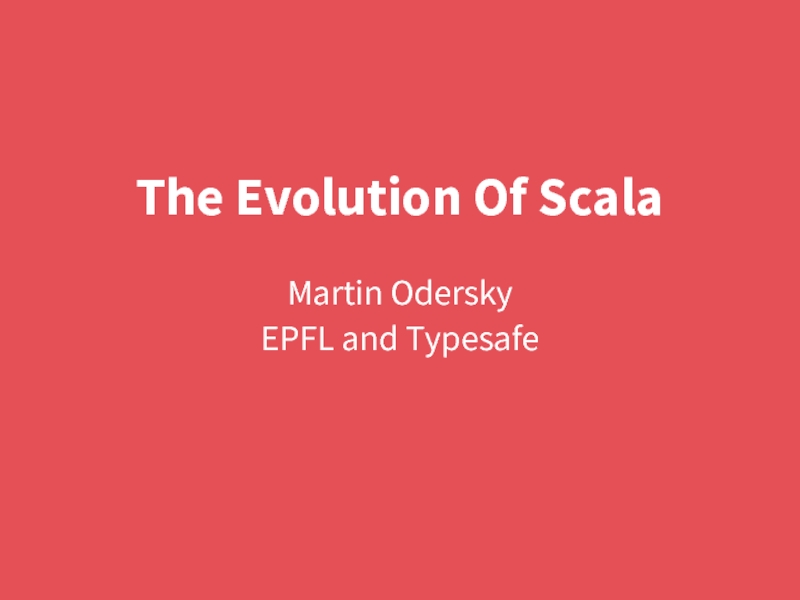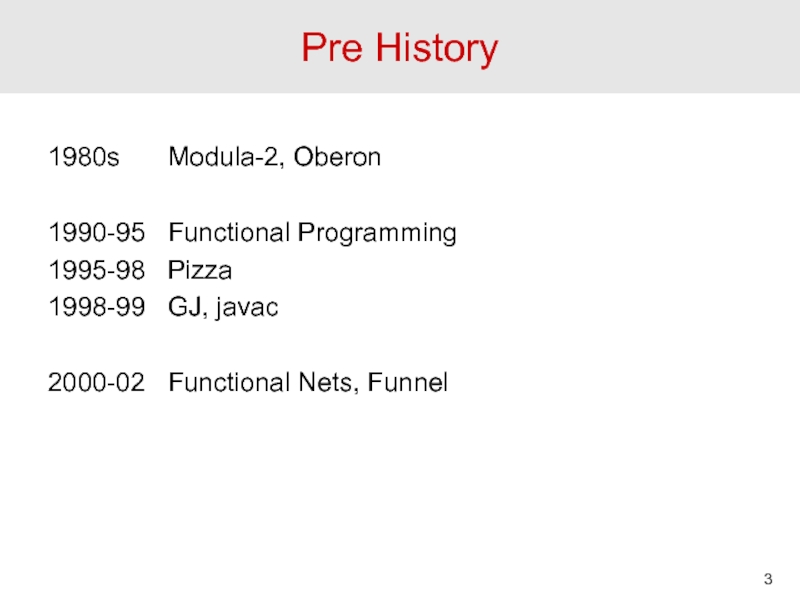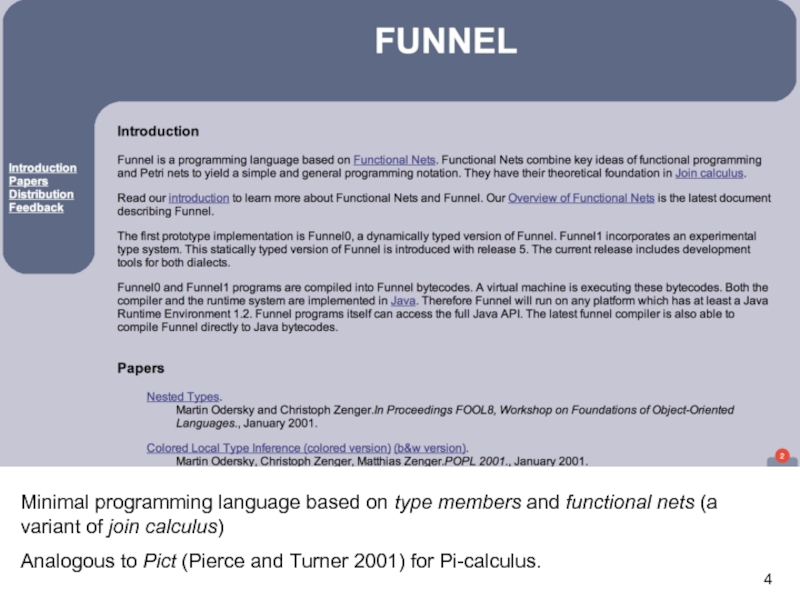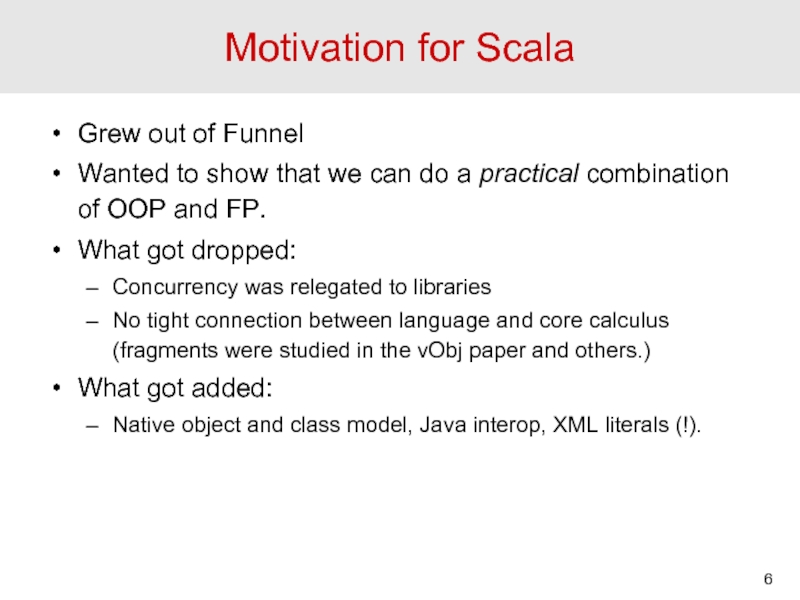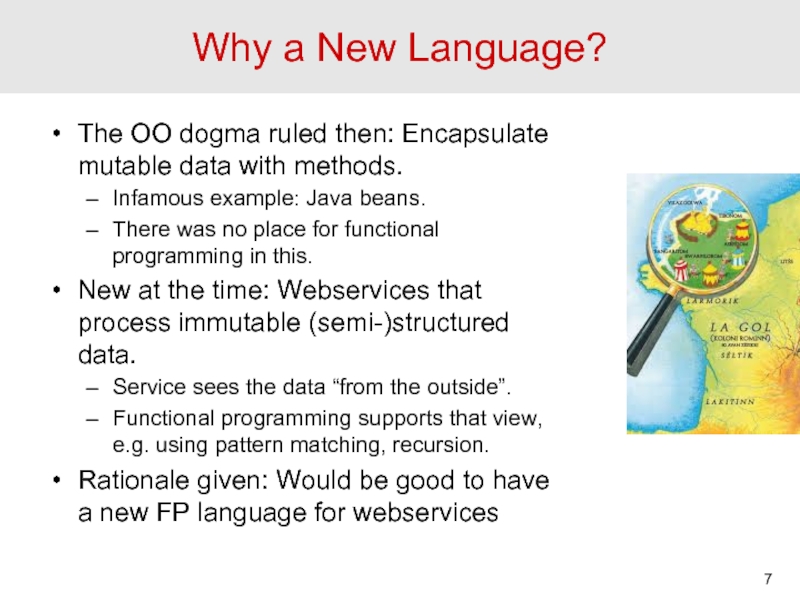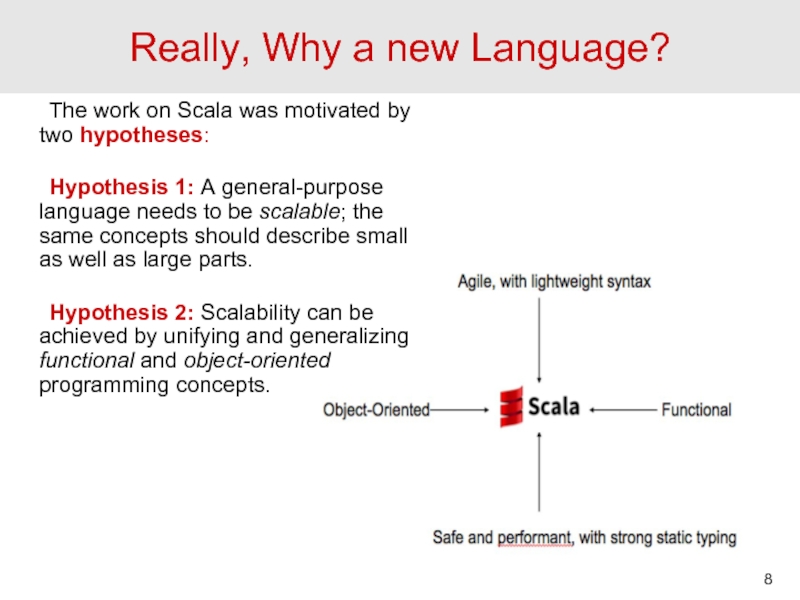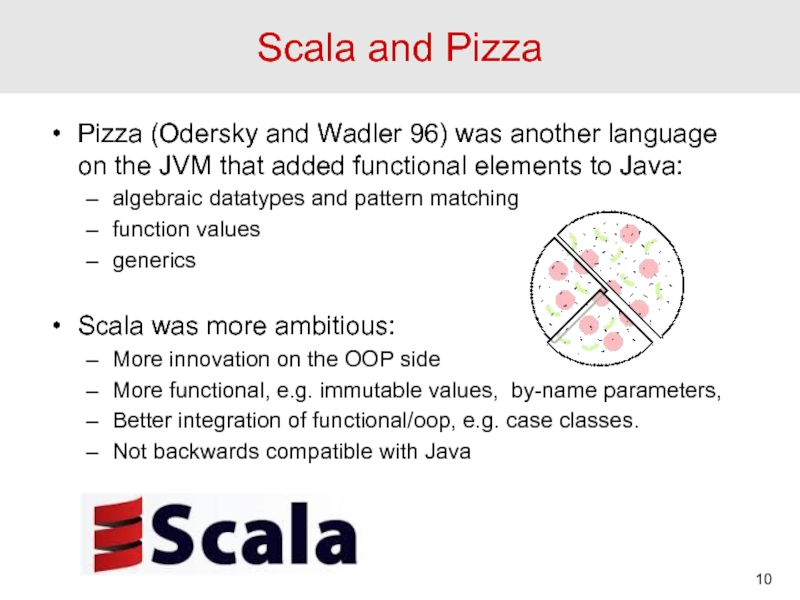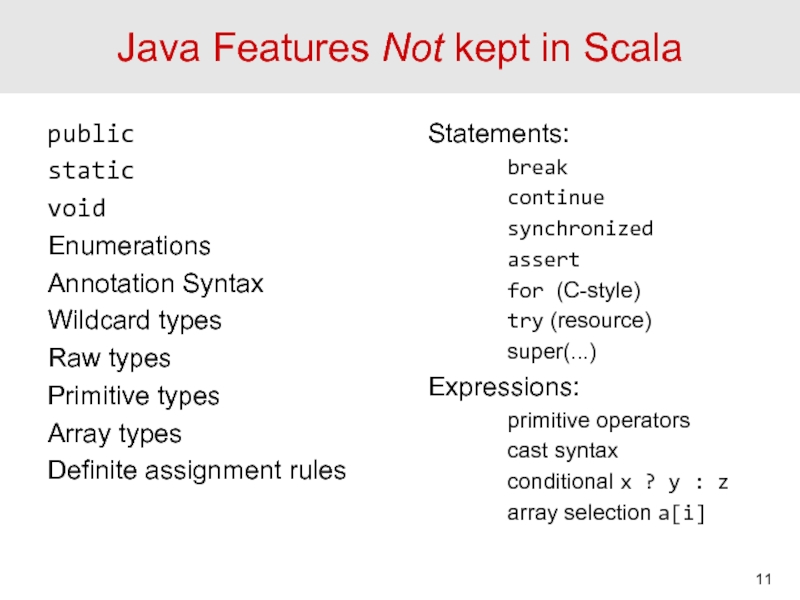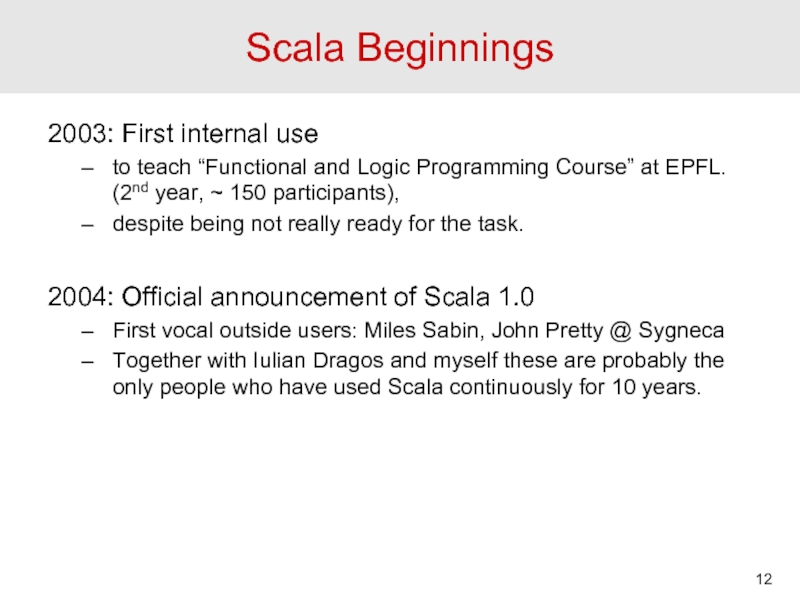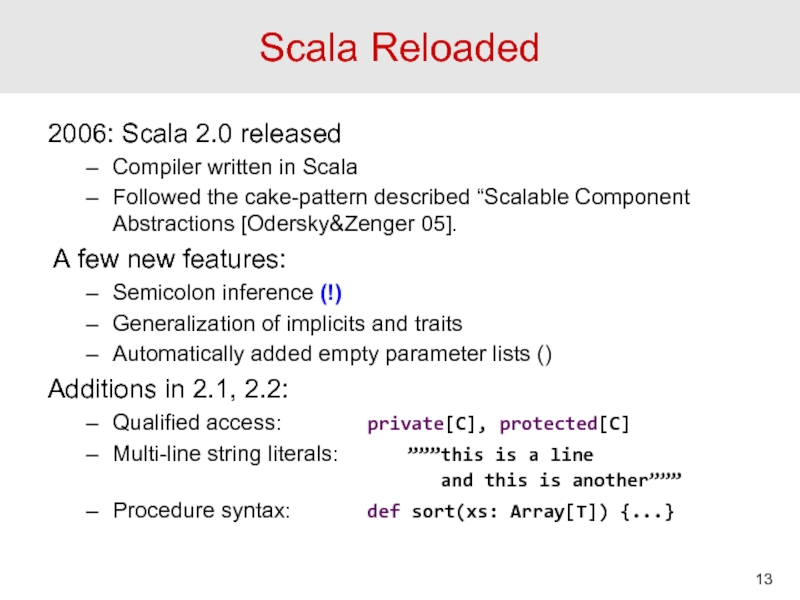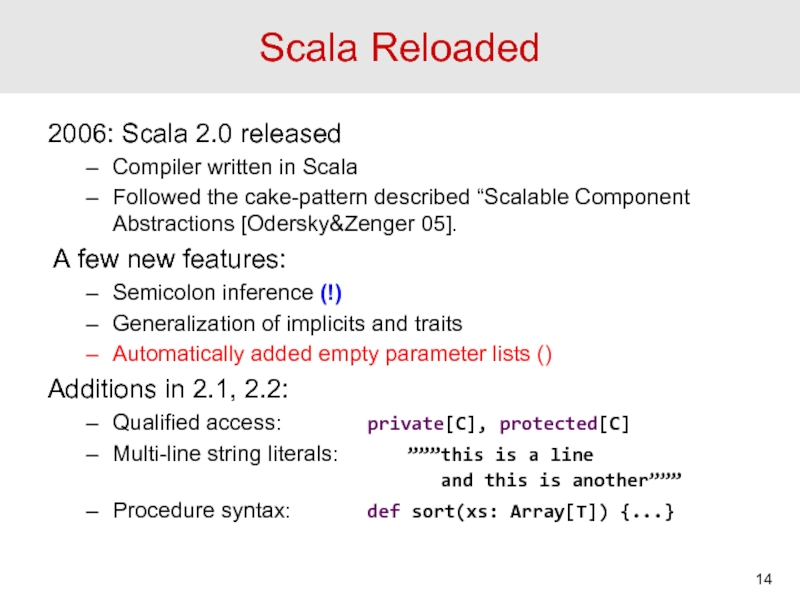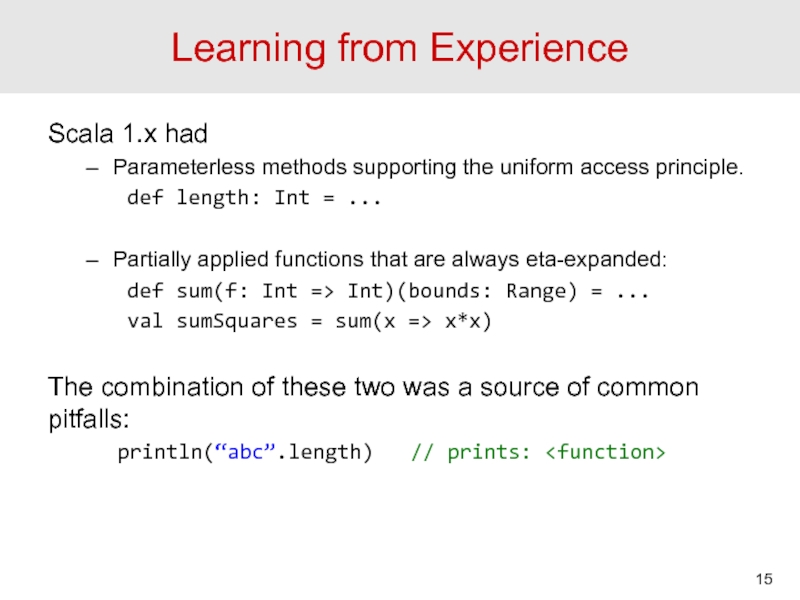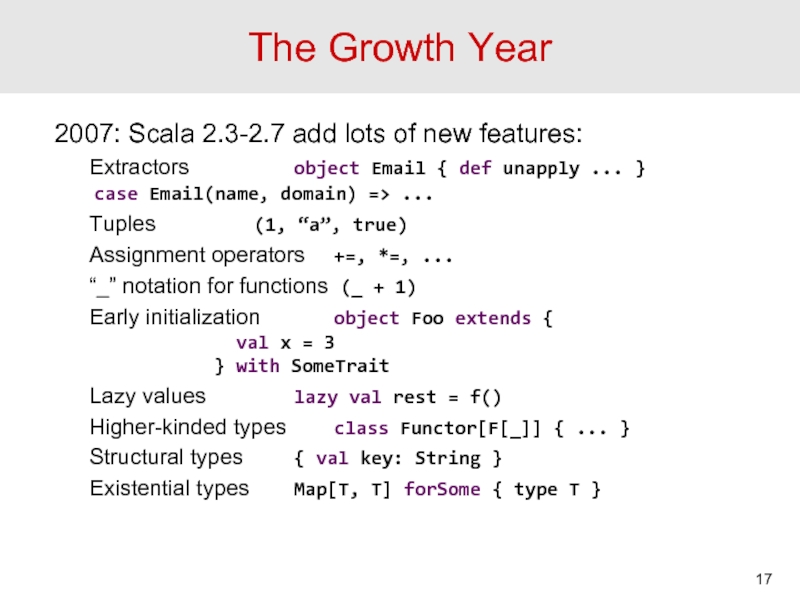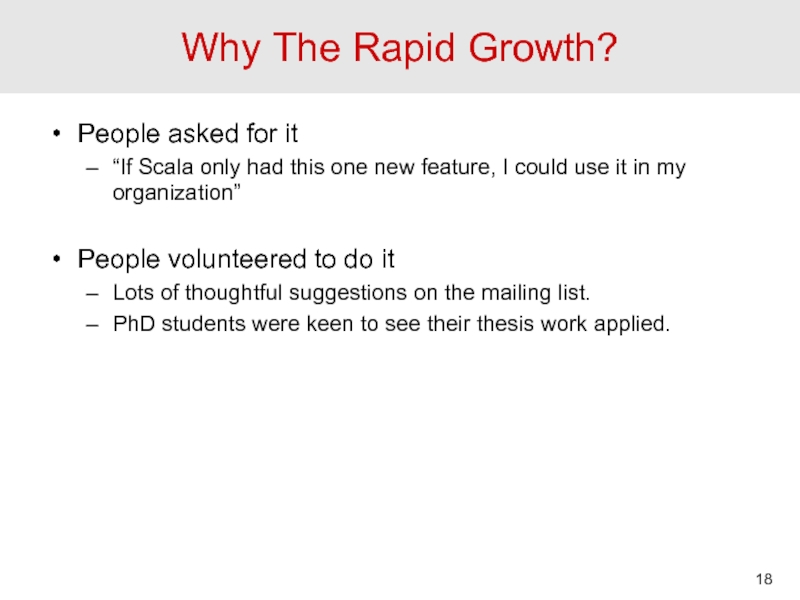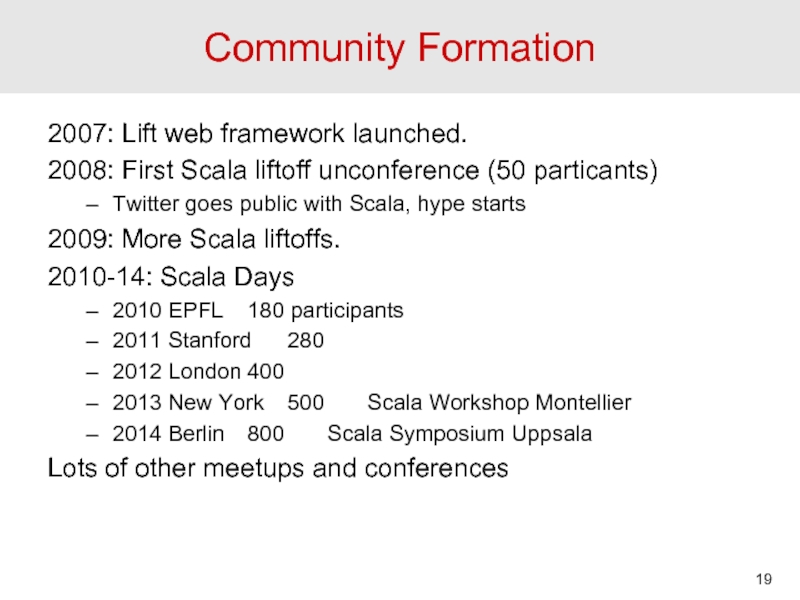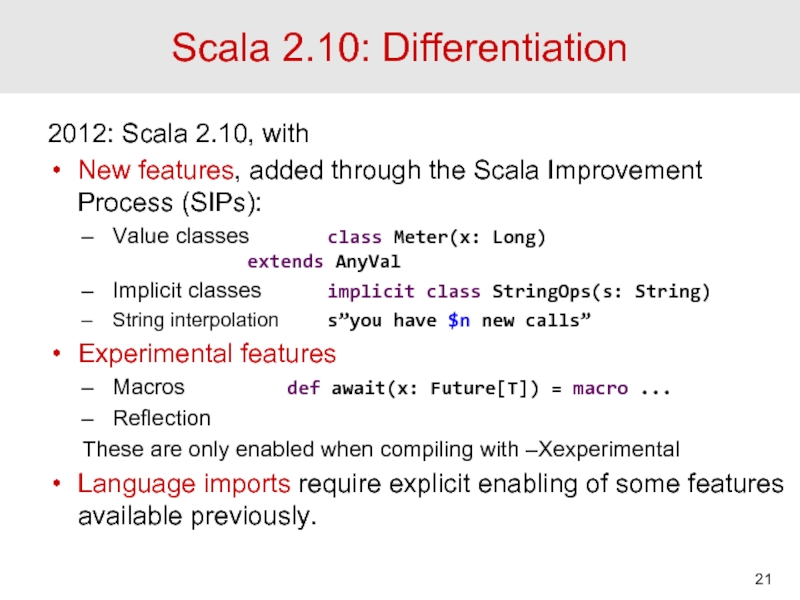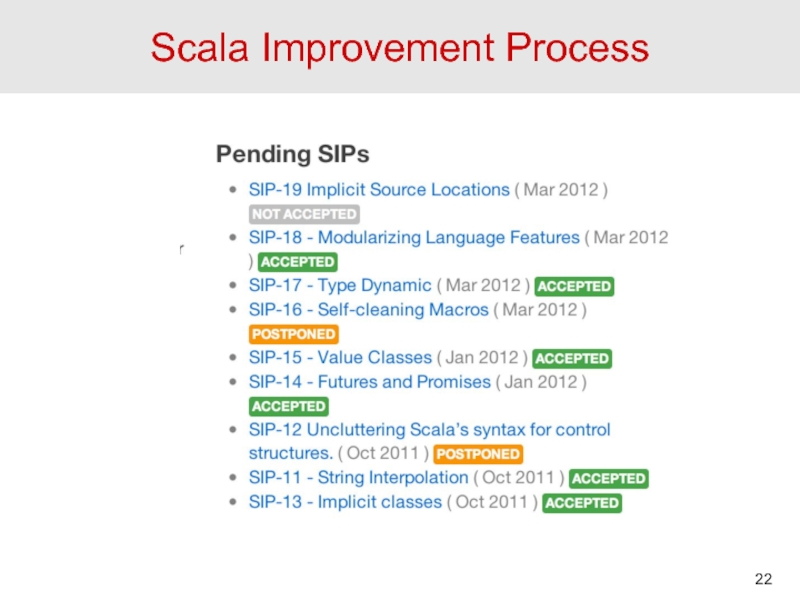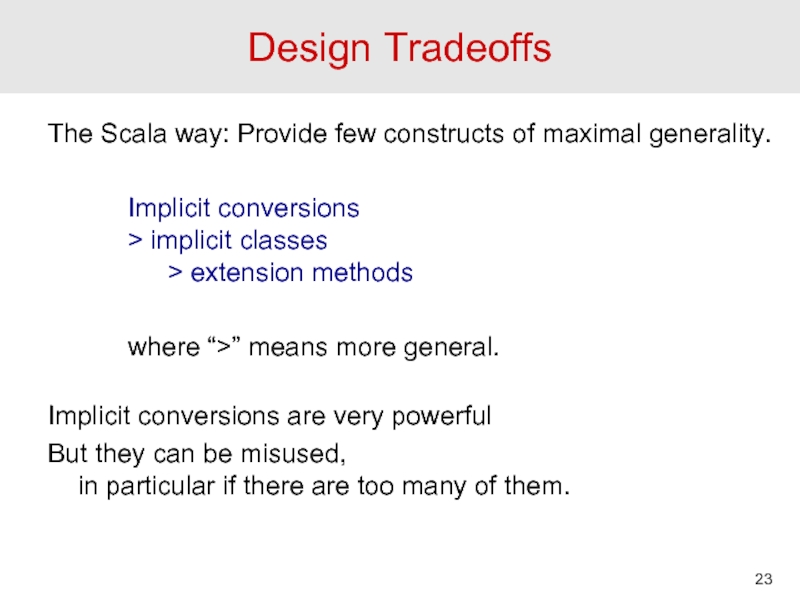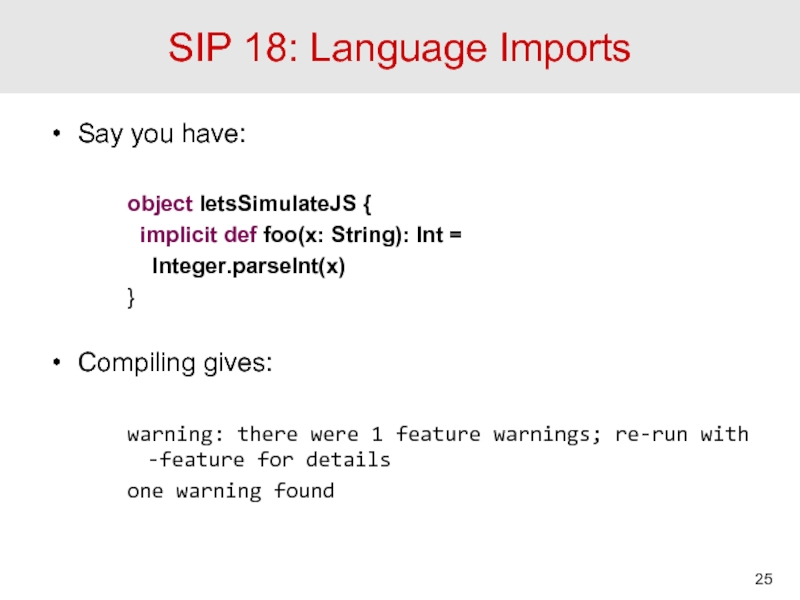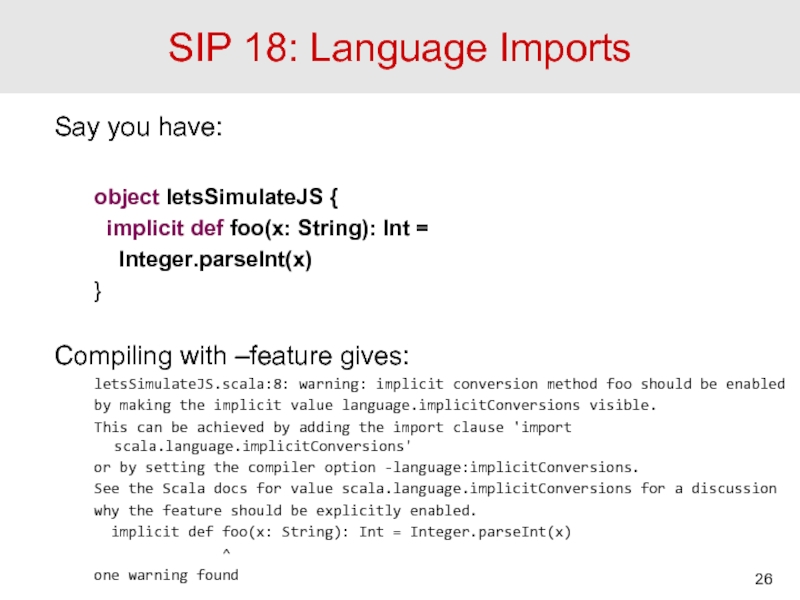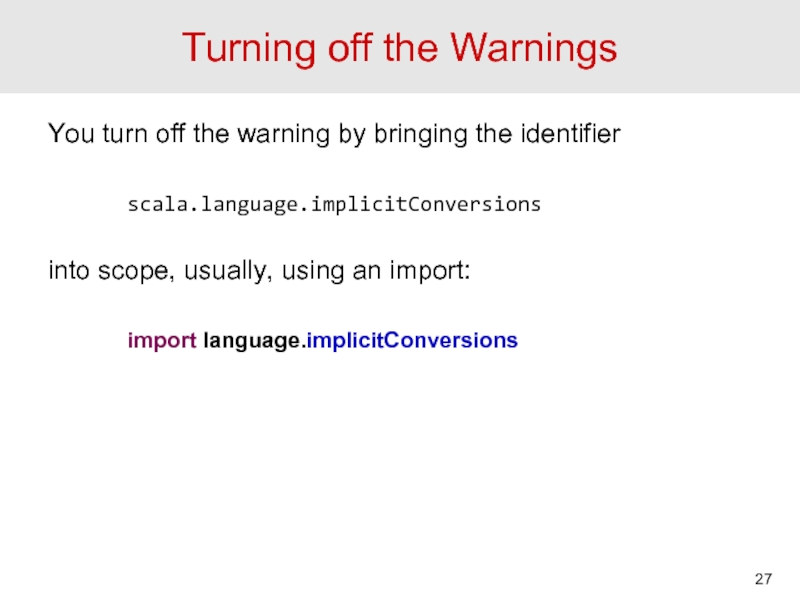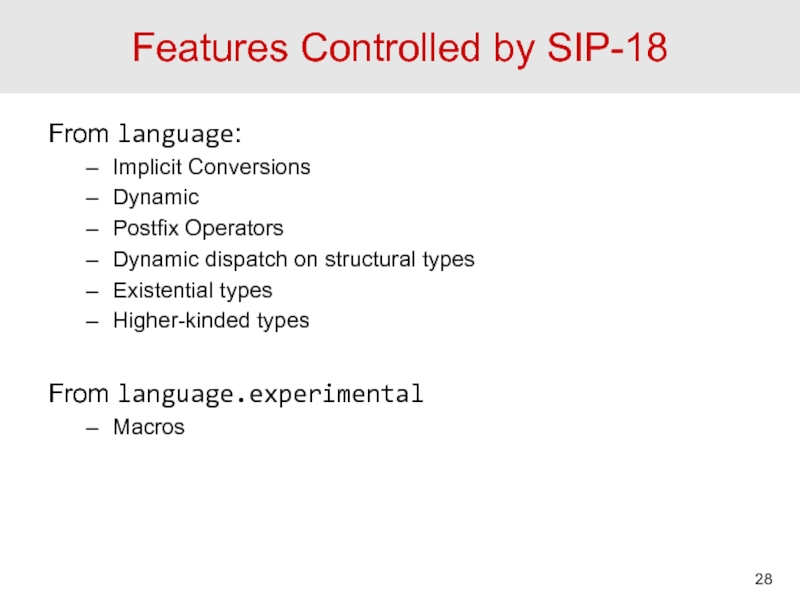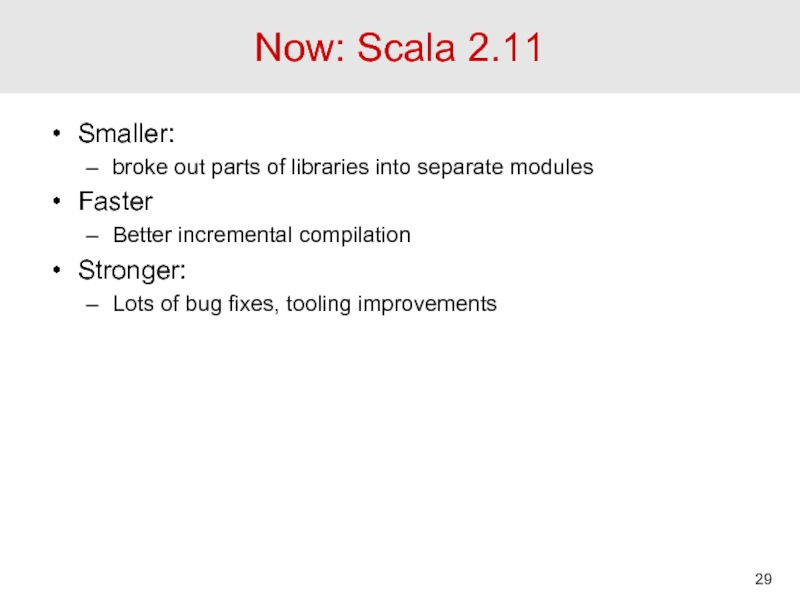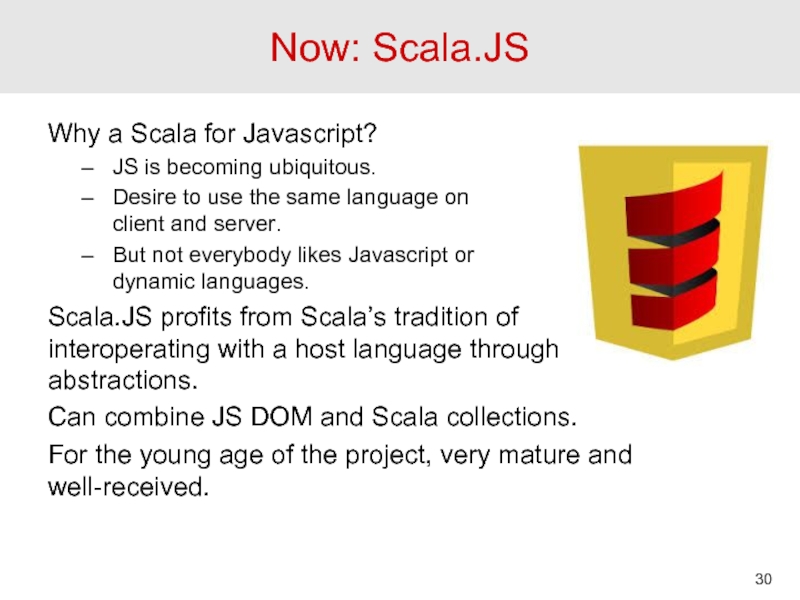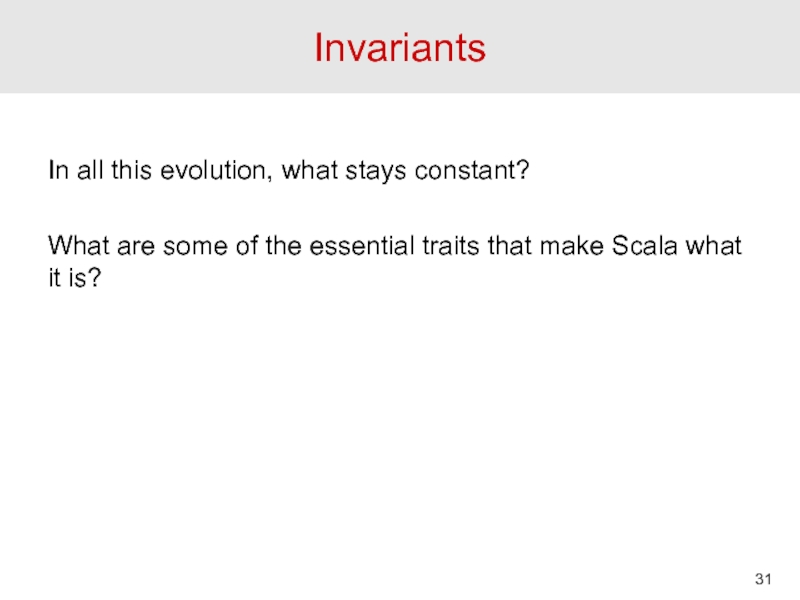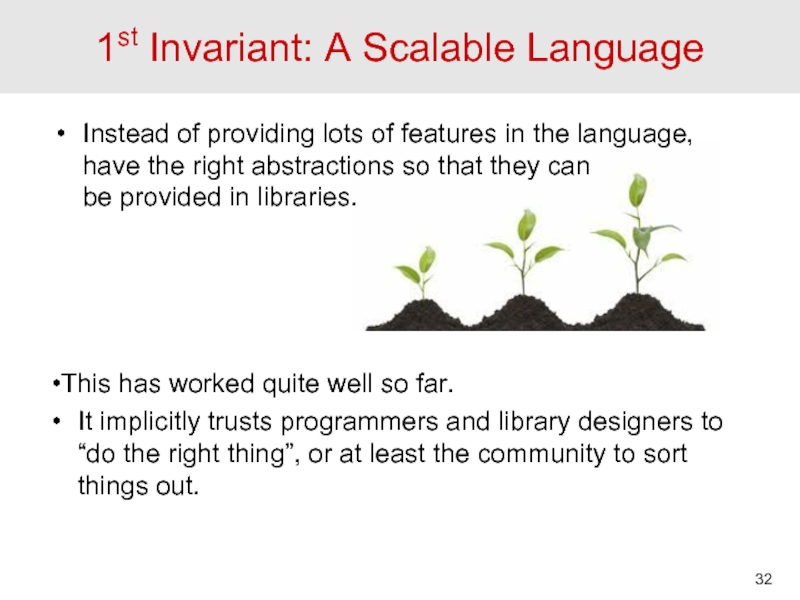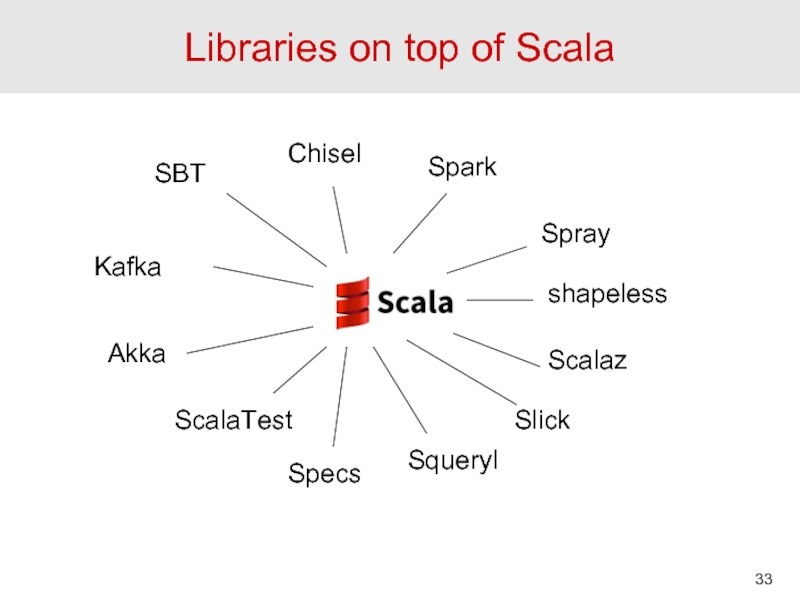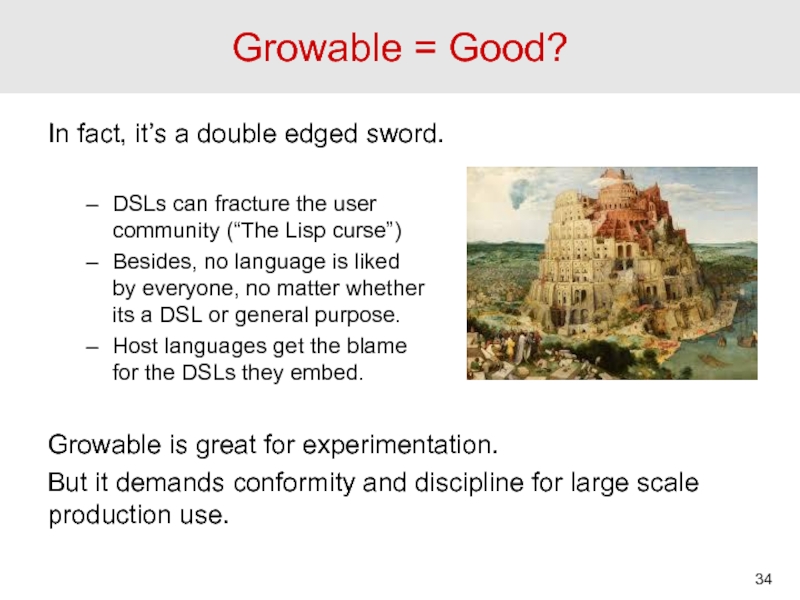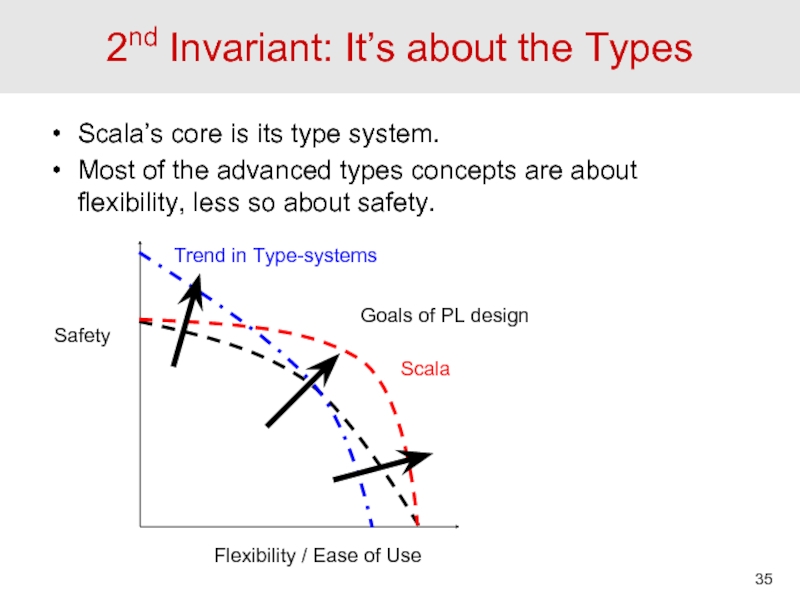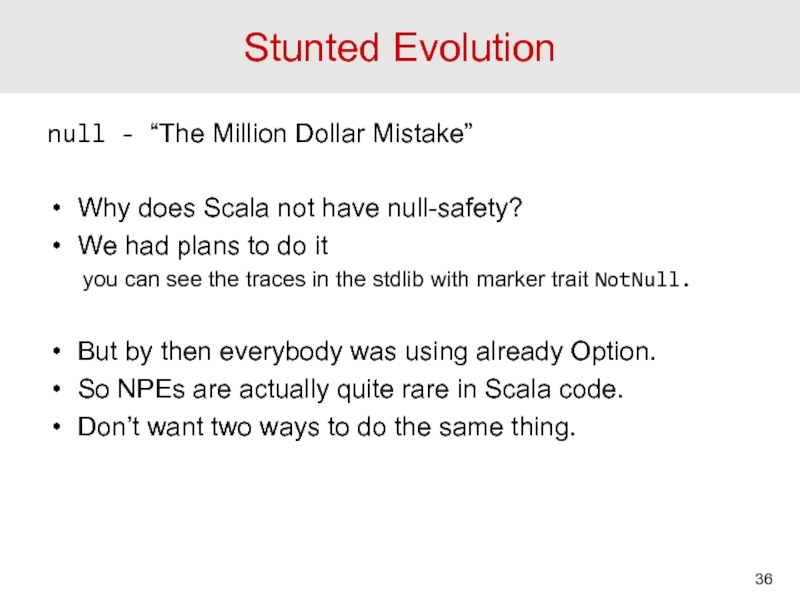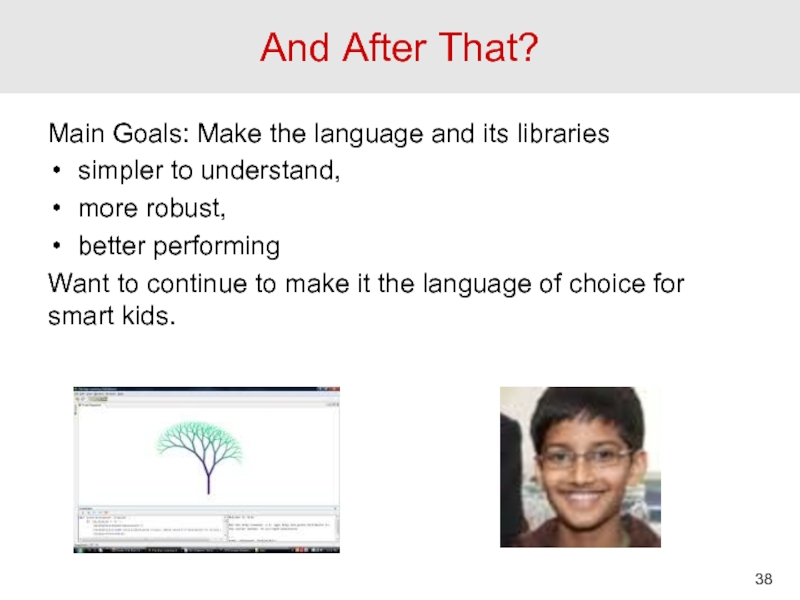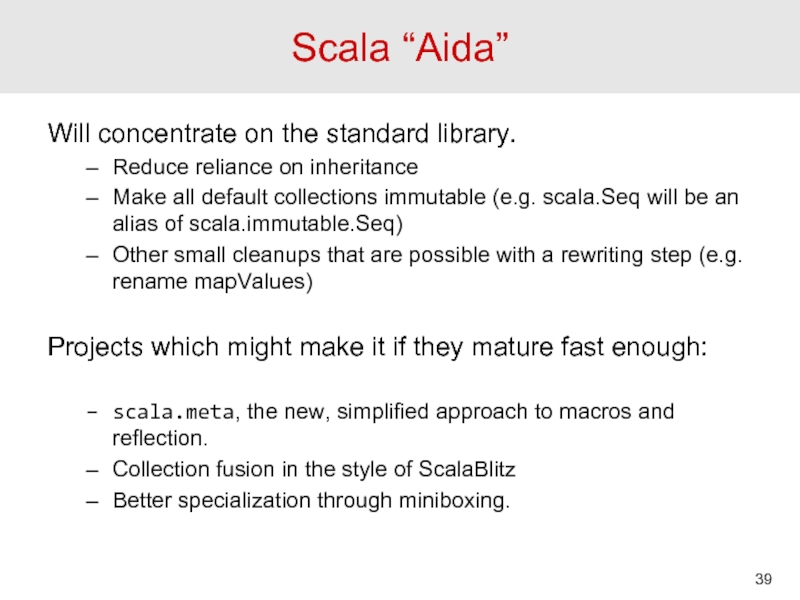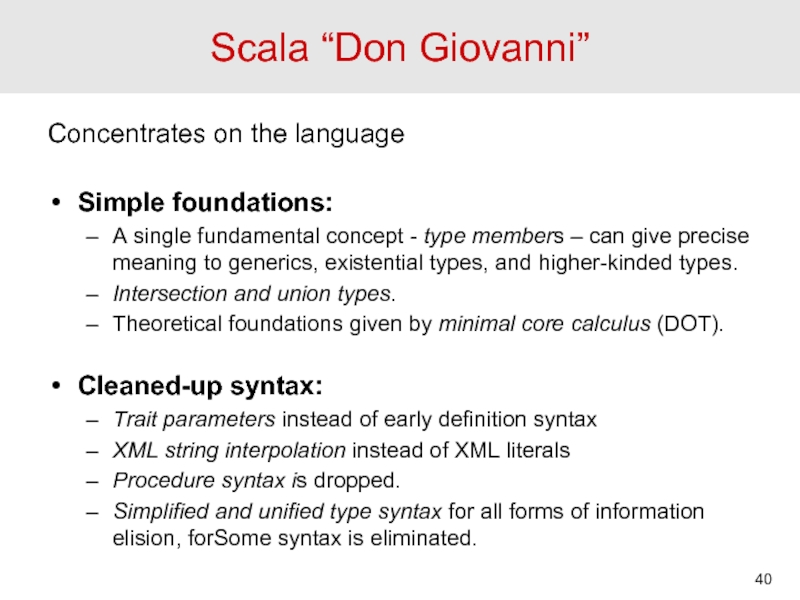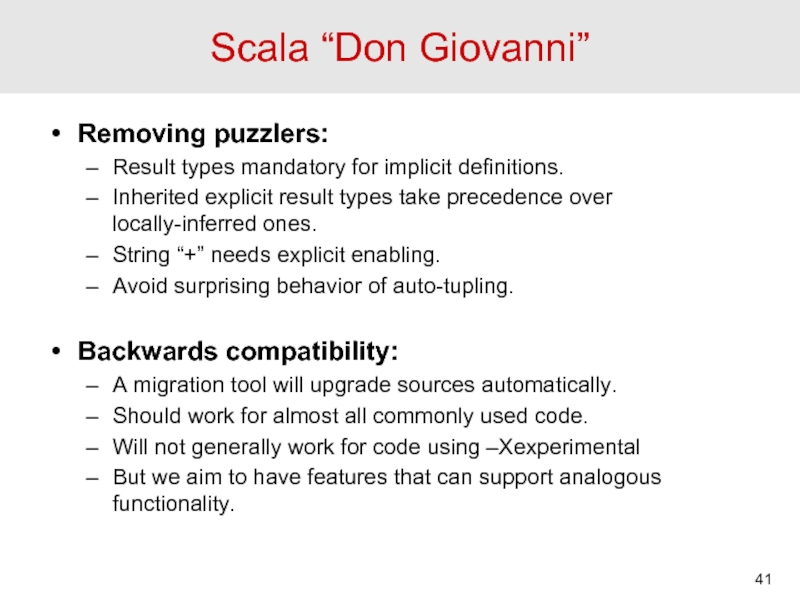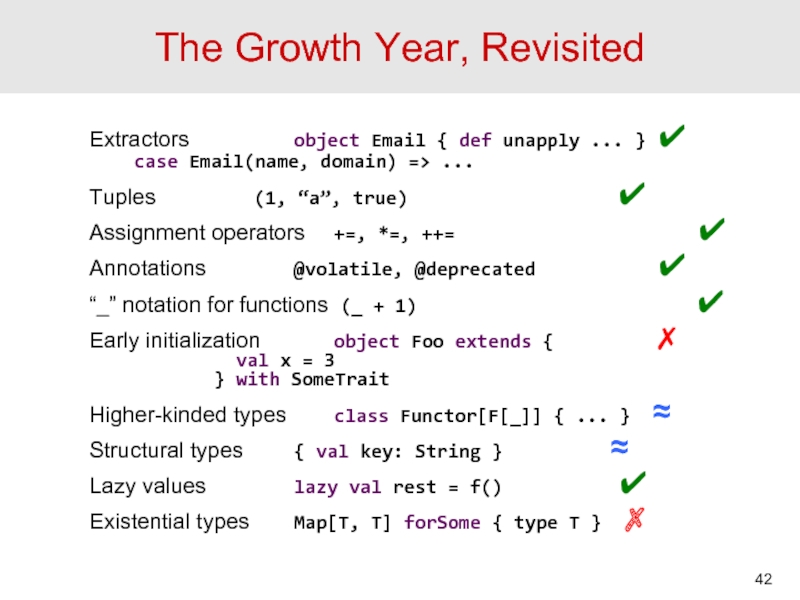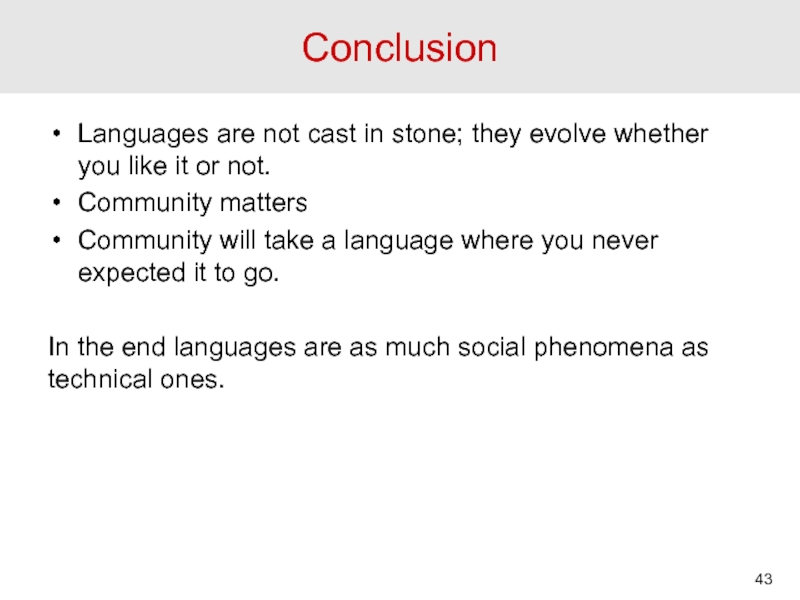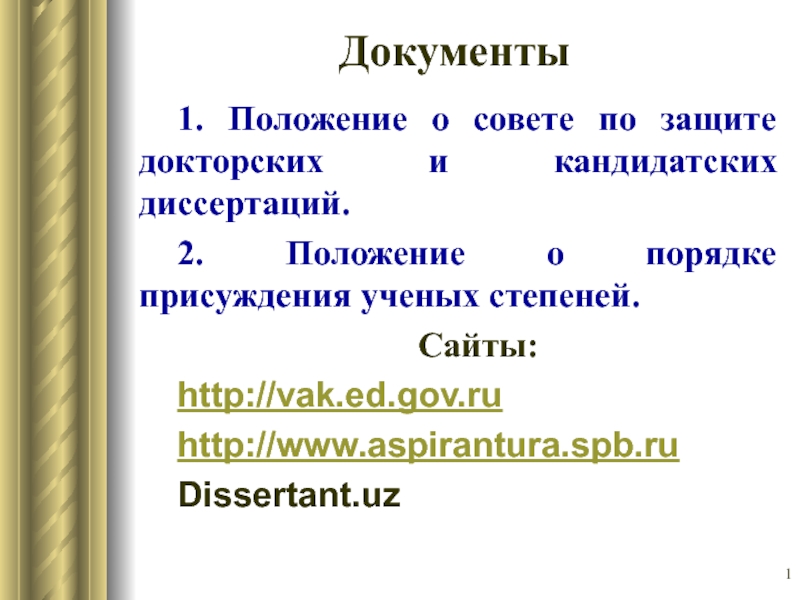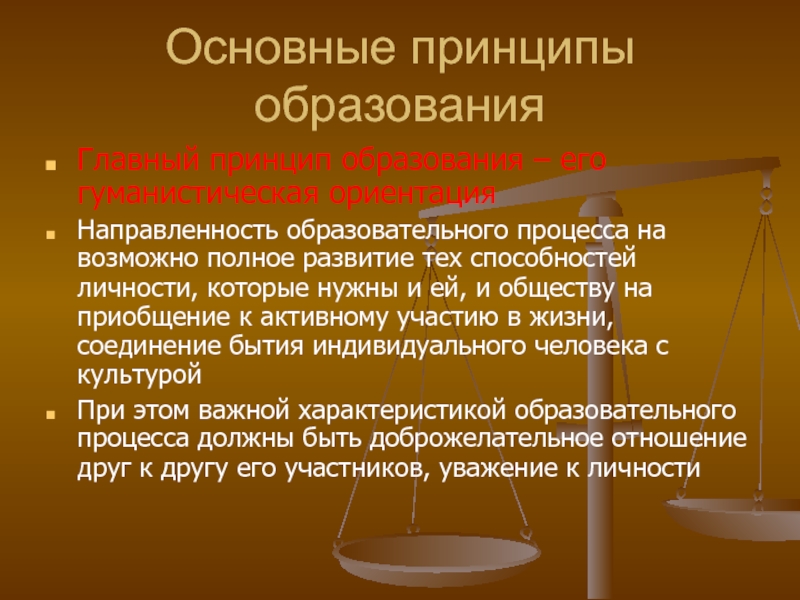- Главная
- Разное
- Дизайн
- Бизнес и предпринимательство
- Аналитика
- Образование
- Развлечения
- Красота и здоровье
- Финансы
- Государство
- Путешествия
- Спорт
- Недвижимость
- Армия
- Графика
- Культурология
- Еда и кулинария
- Лингвистика
- Английский язык
- Астрономия
- Алгебра
- Биология
- География
- Детские презентации
- Информатика
- История
- Литература
- Маркетинг
- Математика
- Медицина
- Менеджмент
- Музыка
- МХК
- Немецкий язык
- ОБЖ
- Обществознание
- Окружающий мир
- Педагогика
- Русский язык
- Технология
- Физика
- Философия
- Химия
- Шаблоны, картинки для презентаций
- Экология
- Экономика
- Юриспруденция
The Evolution Of Scala презентация
Содержание
- 1. The Evolution Of Scala
- 2. 10 Years of Scala
- 3. Pre History 1980s Modula-2, Oberon 1990-95 Functional
- 4. Minimal programming language based on type members
- 5. A Minimal Language Idea of Funnel: Show
- 6. Motivation for Scala Grew out of Funnel
- 7. Why a New Language? The OO dogma
- 8. Really, Why a new Language? The work
- 9. How That Worked Out (from:James Iry: A
- 10. Scala and Pizza Pizza (Odersky and Wadler
- 11. Java Features Not kept in Scala public
- 12. Scala Beginnings 2003: First internal use to
- 13. Scala Reloaded 2006: Scala 2.0 released Compiler
- 14. Scala Reloaded 2006: Scala 2.0 released Compiler
- 15. Learning from Experience Scala 1.x had Parameterless
- 16. Avoiding the Pitfalls Auto-add () for references
- 17. The Growth Year 2007: Scala 2.3-2.7 add
- 18. Why The Rapid Growth? People asked for
- 19. Community Formation 2007: Lift web framework launched.
- 20. Scala 2.8 and 2.9: Consolidation 2010: Scala
- 21. Scala 2.10: Differentiation 2012: Scala 2.10, with
- 22. Scala Improvement Process
- 23. Design Tradeoffs The Scala way: Provide few
- 24. General Problem Scala is geared for orthogonality
- 25. SIP 18: Language Imports Say you have:
- 26. SIP 18: Language Imports Say you have:
- 27. Turning off the Warnings You turn off
- 28. Features Controlled by SIP-18 From language: Implicit
- 29. Now: Scala 2.11 Smaller: broke out parts
- 30. Now: Scala.JS Why a Scala for Javascript?
- 31. Invariants In all this evolution, what
- 32. 1st Invariant: A Scalable Language Instead of
- 33. Libraries on top of Scala SBT Chisel
- 34. Growable = Good? In fact, it’s a
- 35. Scala’s core is its type system. Most
- 36. Stunted Evolution null - “The Million Dollar
- 37. What’s Next? Scala 2.12 will be a
- 38. And After That? Main Goals: Make the
- 39. Scala “Aida” Will concentrate on the standard
- 40. Scala “Don Giovanni” Concentrates on the language
- 41. Scala “Don Giovanni” Removing puzzlers: Result
- 42. The Growth Year, Revisited Extractors object Email {
- 43. Conclusion Languages are not cast in stone;
Слайд 3Pre History
1980s Modula-2, Oberon
1990-95 Functional Programming
1995-98 Pizza
1998-99 GJ, javac
2000-02 Functional Nets, Funnel
Слайд 4Minimal programming language based on type members and functional nets (a
Analogous to Pict (Pierce and Turner 2001) for Pi-calculus.
Слайд 5A Minimal Language
Idea of Funnel: Show that we can build a
General: OO, functional + imperative, concurrent
Core calculus: Functional nets
Sugar: Records, Lambdas, Type members.
Wrote some programs (including parts of the Funnel library) in Funnel.
Quickly became apparent that encodings suck:
Confusing for beginners
Boring to do them over and over again for experts
Слайд 6Motivation for Scala
Grew out of Funnel
Wanted to show that we can
What got dropped:
Concurrency was relegated to libraries
No tight connection between language and core calculus (fragments were studied in the νObj paper and others.)
What got added:
Native object and class model, Java interop, XML literals (!).
Слайд 7Why a New Language?
The OO dogma ruled then: Encapsulate mutable data
Infamous example: Java beans.
There was no place for functional programming in this.
New at the time: Webservices that process immutable (semi-)structured data.
Service sees the data “from the outside”.
Functional programming supports that view, e.g. using pattern matching, recursion.
Rationale given: Would be good to have a new FP language for webservices
Слайд 8Really, Why a new Language?
The work on Scala was motivated by
Hypothesis 1: A general-purpose language needs to be scalable; the same concepts should describe small as well as large parts.
Hypothesis 2: Scalability can be achieved by unifying and generalizing functional and object-oriented programming concepts.
Слайд 9How That Worked Out
(from:James Iry: A Brief, Incomplete, and Mostly Wrong
Слайд 10Scala and Pizza
Pizza (Odersky and Wadler 96) was another language on
algebraic datatypes and pattern matching
function values
generics
Scala was more ambitious:
More innovation on the OOP side
More functional, e.g. immutable values, by-name parameters,
Better integration of functional/oop, e.g. case classes.
Not backwards compatible with Java
Слайд 11Java Features Not kept in Scala
public
static
void
Enumerations
Annotation Syntax
Wildcard types
Raw types
Primitive types
Array types
Definite
Statements:
break
continue
synchronized
assert
for (C-style)
try (resource)
super(...)
Expressions:
primitive operators
cast syntax
conditional x ? y : z
array selection a[i]
Слайд 12Scala Beginnings
2003: First internal use
to teach “Functional and Logic Programming Course”
despite being not really ready for the task.
2004: Official announcement of Scala 1.0
First vocal outside users: Miles Sabin, John Pretty @ Sygneca
Together with Iulian Dragos and myself these are probably the only people who have used Scala continuously for 10 years.
Слайд 13Scala Reloaded
2006: Scala 2.0 released
Compiler written in Scala
Followed the cake-pattern described
A few new features:
Semicolon inference (!)
Generalization of implicits and traits
Automatically added empty parameter lists ()
Additions in 2.1, 2.2:
Qualified access: private[C], protected[C]
Multi-line string literals: ”””this is a line and this is another”””
Procedure syntax: def sort(xs: Array[T]) {...}
Слайд 14Scala Reloaded
2006: Scala 2.0 released
Compiler written in Scala
Followed the cake-pattern described
A few new features:
Semicolon inference (!)
Generalization of implicits and traits
Automatically added empty parameter lists ()
Additions in 2.1, 2.2:
Qualified access: private[C], protected[C]
Multi-line string literals: ”””this is a line and this is another”””
Procedure syntax: def sort(xs: Array[T]) {...}
Слайд 15Learning from Experience
Scala 1.x had
Parameterless methods supporting the uniform access principle.
def
Partially applied functions that are always eta-expanded:
def sum(f: Int => Int)(bounds: Range) = ...
val sumSquares = sum(x => x*x)
The combination of these two was a source of common pitfalls:
println(“abc”.length) // prints:
Слайд 16Avoiding the Pitfalls
Auto-add () for references f is to nullary functions
def f() = ...
Eta-expand only if
expected type is a function
or
missing parameters are specified with `_’
Слайд 17The Growth Year
2007: Scala 2.3-2.7 add lots of new features:
Extractors object Email
Tuples (1, “a”, true)
Assignment operators +=, *=, ...
“_” notation for functions (_ + 1)
Early initialization object Foo extends { val x = 3 } with SomeTrait
Lazy values lazy val rest = f()
Higher-kinded types class Functor[F[_]] { ... }
Structural types { val key: String }
Existential types Map[T, T] forSome { type T }
Слайд 18Why The Rapid Growth?
People asked for it
“If Scala only had this
People volunteered to do it
Lots of thoughtful suggestions on the mailing list.
PhD students were keen to see their thesis work applied.
Слайд 19Community Formation
2007: Lift web framework launched.
2008: First Scala liftoff unconference
Twitter goes public with Scala, hype starts
2009: More Scala liftoffs.
2010-14: Scala Days
2010 EPFL 180 participants
2011 Stanford 280
2012 London 400
2013 New York 500 Scala Workshop Montellier
2014 Berlin 800 Scala Symposium Uppsala
Lots of other meetups and conferences
Слайд 20Scala 2.8 and 2.9: Consolidation
2010: Scala 2.8, with
New collections with bitrot
Fixed leaky array model.
New semantics of nested packages.
Better type inference for implicit resolution
Lots of bug-fixes
2011: Scala 2.9, with
Parallel collections
Special trait DelayedInit, used in App
Trait Dynamic, to interface with dynamic languages
Слайд 21Scala 2.10: Differentiation
2012: Scala 2.10, with
New features, added through the Scala
Value classes class Meter(x: Long) extends AnyVal
Implicit classes implicit class StringOps(s: String)
String interpolation s”you have $n new calls”
Experimental features
Macros def await(x: Future[T]) = macro ...
Reflection
These are only enabled when compiling with –Xexperimental
Language imports require explicit enabling of some features available previously.
Слайд 23Design Tradeoffs
The Scala way: Provide few constructs of maximal generality.
Implicit conversions
where “>” means more general.
Implicit conversions are very powerful
But they can be misused, in particular if there are too many of them.
Слайд 24General Problem
Scala is geared for orthogonality and expressiveness
I believe that in
But there are challenges.
Some combinations of language features might be less desirable than others.
How to avoid feature misuse?
Idea: Have a mechanism that demands that some problematic features are explicitly imported (Haskell uses something similar).
Слайд 25SIP 18: Language Imports
Say you have:
object letsSimulateJS {
implicit def foo(x:
Integer.parseInt(x)
}
Compiling gives:
warning: there were 1 feature warnings; re-run with -feature for details
one warning found
Слайд 26SIP 18: Language Imports
Say you have:
object letsSimulateJS {
implicit def foo(x:
Integer.parseInt(x)
}
Compiling with –feature gives:
letsSimulateJS.scala:8: warning: implicit conversion method foo should be enabled
by making the implicit value language.implicitConversions visible.
This can be achieved by adding the import clause 'import scala.language.implicitConversions'
or by setting the compiler option -language:implicitConversions.
See the Scala docs for value scala.language.implicitConversions for a discussion
why the feature should be explicitly enabled.
implicit def foo(x: String): Int = Integer.parseInt(x)
^
one warning found
Слайд 27Turning off the Warnings
You turn off the warning by bringing the
scala.language.implicitConversions
into scope, usually, using an import:
import language.implicitConversions
Слайд 28Features Controlled by SIP-18
From language:
Implicit Conversions
Dynamic
Postfix Operators
Dynamic dispatch on structural types
Existential
Higher-kinded types
From language.experimental
Macros
Слайд 29Now: Scala 2.11
Smaller:
broke out parts of libraries into separate modules
Faster
Better incremental
Stronger:
Lots of bug fixes, tooling improvements
Слайд 30Now: Scala.JS
Why a Scala for Javascript?
JS is becoming ubiquitous.
Desire to use
But not everybody likes Javascript or dynamic languages.
Scala.JS profits from Scala’s tradition of interoperating with a host language through very general abstractions.
Can combine JS DOM and Scala collections.
For the young age of the project, very mature and well-received.
Слайд 31Invariants
In all this evolution, what stays constant?
What are some of the
Слайд 321st Invariant: A Scalable Language
Instead of providing lots of features in
This has worked quite well so far.
It implicitly trusts programmers and library designers to “do the right thing”, or at least the community to sort things out.
Слайд 33Libraries on top of Scala
SBT
Chisel
Spark
Spray
Kafka
Akka
ScalaTest
Squeryl
Specs
shapeless
Scalaz
Slick
Слайд 34Growable = Good?
In fact, it’s a double edged sword.
DSLs can fracture
Besides, no language is liked by everyone, no matter whether its a DSL or general purpose.
Host languages get the blame for the DSLs they embed.
Growable is great for experimentation.
But it demands conformity and discipline for large scale production use.
Слайд 35Scala’s core is its type system.
Most of the advanced types concepts
2nd Invariant: It’s about the Types
Flexibility / Ease of Use
Safety
Scala
Trend in Type-systems
Goals of PL design
Слайд 36Stunted Evolution
null - “The Million Dollar Mistake”
Why does Scala not have
We had plans to do it
you can see the traces in the stdlib with marker trait NotNull.
But by then everybody was using already Option.
So NPEs are actually quite rare in Scala code.
Don’t want two ways to do the same thing.
Слайд 37What’s Next?
Scala 2.12 will be a fairly conservative evolution of 2.11
Main
Scala and Java lambdas can understand each other
SAM method convention added to Scala
Should make use of Java 8 streams
Default methods for traits?
Слайд 38And After That?
Main Goals: Make the language and its libraries
simpler to
more robust,
better performing
Want to continue to make it the language of choice for smart kids.
Слайд 39Scala “Aida”
Will concentrate on the standard library.
Reduce reliance on inheritance
Make all
Other small cleanups that are possible with a rewriting step (e.g. rename mapValues)
Projects which might make it if they mature fast enough:
scala.meta, the new, simplified approach to macros and reflection.
Collection fusion in the style of ScalaBlitz
Better specialization through miniboxing.
Слайд 40Scala “Don Giovanni”
Concentrates on the language
Simple foundations:
A single fundamental concept -
Intersection and union types.
Theoretical foundations given by minimal core calculus (DOT).
Cleaned-up syntax:
Trait parameters instead of early definition syntax
XML string interpolation instead of XML literals
Procedure syntax is dropped.
Simplified and unified type syntax for all forms of information elision, forSome syntax is eliminated.
Слайд 41Scala “Don Giovanni”
Removing puzzlers:
Result types mandatory for implicit definitions.
Inherited explicit
String “+” needs explicit enabling.
Avoid surprising behavior of auto-tupling.
Backwards compatibility:
A migration tool will upgrade sources automatically.
Should work for almost all commonly used code.
Will not generally work for code using –Xexperimental
But we aim to have features that can support analogous functionality.
Слайд 42The Growth Year, Revisited
Extractors object Email { def unapply ... } ✔
Tuples (1, “a”, true) ✔
Assignment operators +=, *=, ++= ✔
Annotations @volatile, @deprecated ✔
“_” notation for functions (_ + 1) ✔
Early initialization object Foo extends { ✗ val x = 3 } with SomeTrait
Higher-kinded types class Functor[F[_]] { ... } ≈
Structural types { val key: String } ≈
Lazy values lazy val rest = f() ✔
Existential types Map[T, T] forSome { type T } ✗
Слайд 43Conclusion
Languages are not cast in stone; they evolve whether you like
Community matters
Community will take a language where you never expected it to go.
In the end languages are as much social phenomena as technical ones.
